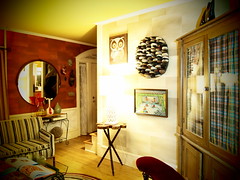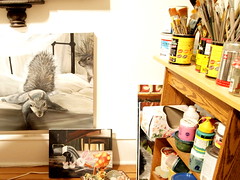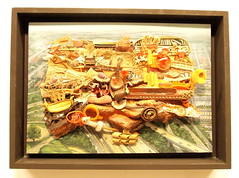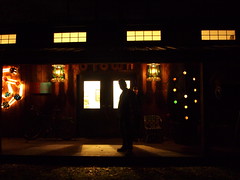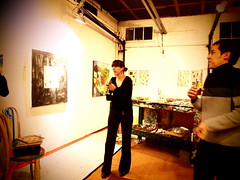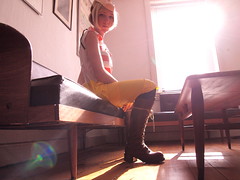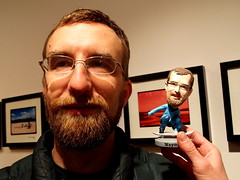
Thursday, January 28, 2010
Oh boy Mr. Fairey is at it once again.
This is staring to sound like an after school special or something from Matlock.
"The U.S. Attorney's office had a grand jury begin an investigation after Fairey said he erred about which AP photo he used as the basis for ''HOPE'' and had submitted false images and deleted other images to conceal his mistake."
To not run into the same problems please click Ny Times to view the rest of the story.
Thursday, January 21, 2010
A studio and home visit with the Linden's.
Thursday, January 14, 2010
A look forward to our artists of Feb.

Slingluff Gallery dot com
October 2002
An Interview with Steve and Dawn Linden
Established artists Steve and Dawn Linden own a decorative arts gallery, Visual Mixology, located on 6th Street in Stroudsburg, PA. A Long Island native, Steve Linden began his training at the Rochester Institute of Technology and later transferred to the Boston Museum School of Fine Arts. There he met Dawn Linden, originally from Stroudsburg, who transferred there from Drew University after she realized she wanted to be an artist at a serious school. After establishing themselves in the New York art scene with Mr. Linden’s found art sculptures and mosaics and Mrs. Linden’s paintings, they moved to Monroe County because they felt a need to bring their innovative art into the suburbs where they saw a lack of artistic appreciation. Two years ago, they opened Visual Mixology in order to have a way for the public to view their work. Living in what they call “the rest of America,” they continually seek ways to bring artistic vision into people’s lives. They accomplish this through displaying work in their shop and local venues and through designing and implementing artistic interiors in local homes and businesses. On a brisk October evening, they arrived at Sarah Street Bar and Grill to talk about their success as artists and to offer their perspective on the function of art in a world that they feel desperately needs it.
Alanna Reeser: Who influenced you artistically growing up?
Steve Linden: Jimi Hendrix.
Dawn Linden: Jackson Pollock.
SL: My influences were mostly musical instead of the visual artists – John Coltrane, James Brown. I love Picasso, too. He was the broadest visual artist that ever was as far as I am concerned. It sounds cliché, but it is true.
DL: Frida, Georgia O’Keefe. Women that found their own way.
AR: Do they remain influential?
DL: Yes. I always tend to aspire to an attainable goal.
SL: Yes, when you see greatness, as an artist, you look for other people’s art that makes you feel that it is worth being an artist and hopeful because you see something that you did not know it was possible to make. Inspiration is what you are looking for, and it is hard to find. Many artists are sheep following the same art movement; you can cancel out 90% of art because you know you can do it. Occasionally you see something that you did not know could exist.
AR: In addition to influential people, what inspires you from the physical world?
SL: Most of my inspiration comes from what is available in terms of stuff that is made in the world. How else you can look at it and what else you can make out of it inspires me also.
DL: Mine comes from nature, the metaphysical, the unseen world, and our connection to them.
AR: When did you move to Stroudsburg and why?
DL: After I had my first child, I up and left Williamsburg because there were rats. I guess it was 1984. It was a transition period – Steve stayed in the city for a year or two. Moving away from an urban area that is really cultured and educated changes everything. We did not expect such a difference.
SL: The arts were on a higher plane there.
DL: All of the art fields were. There was such a difference in receptivity and the degree of liberalism here.
SL: Moving here seemed like moving in with primates on some level.
DL: It was pure culture shock.
AR: When did you open your shop and why?
SL: Much later.
DL: We were trying to appeal to the primates (laugh) in a useful way with decorative objects instead of fine arts. It was a brutal assessment we had to make, and we looked at it as our masters degrees, as a way to work hard and come up with something.
SL: We were tired of working for other people and not being in control of our own abilities. We thought that there was a market for our abilities that no one could see without a public forum for them. Then it becomes real to people who have no idea about anything.
DL: It has been rewarding to reach out to people artistically.
SL: It has always been a dream of mine to engage the numb masses of America with vision, with something that is not available in Wal-Marts or carpet stores, with something that is…
DL: …art. We go into homes because we do a lot of interiors, and there is nothing on the walls. You know, you can go to a flea market and pick up a painting for five bucks, but no one thinks of what it can add, of what it can bring to their lives, as opposed to what they can get at Rosen’s Furniture, for example. There is a richness that America in general…
SL: …needs to acquire a taste for to survive the 21st century. What it comes down to is dealing with the infantile sensibilities of the country.
DL: America is a complete cultural void. Culture is something that comes with age.
SL: And even though it may seem like a luxury, it is a necessity for normality. It really is.
AR: What are some of the responses or questions you receive from people in your shop?
DL: ‘This is a cool art store.’ Our sign on the sidewalk says, ‘cool art store,’ with an arrow. At least they agree. And it is nice to have people walk in and look around in amazement. They also wonder how long it took us to make the stuff. That is a big question. Honestly though, there is a general response that it is magical and beautiful. Occasionally though, people do just walk right out!
SL: It is radical to be sort of an ex-patriot of the New York art world and move an hour and a half outside of that art world to an America where no one has a clue that there is a use or a need for art, culture, vision or anything innovative. It is radical to step into America with a unique vision.
DL: ‘What are you doing here?’ That is another big question we get.
SL: Yeah, well, we already were in Soho, and we should be in America because America needs us. That is why we are here. It is pioneering really. Being art pioneers is amazing.
AR: I heard that you have a piece of art at “Ripley’s Believe It or Not.” How did that come about?
SL: Dawn and I went to St. Augustine, Florida, and we went to one of their museums. We got home, and I thought, ‘Why not try to sell them this giant kaleidoscope?’ I sent them photographs of it, and they bought it.
DL: I think it was shipped to China. It was really popular in Asia.
AR: Do you ever wonder where it is?
SL: Well, you do give birth to art, and the one thing that you want is for it to leave home. The most depressing thing is when it stays around the house. It feels good to make something and have someone buy it and want to do something with it. It makes you feel hopeful as an artist.
AR: As far as your interior work, are your jobs always collaborative?
SL: No, we do very different things. Dawn does everything that involves paint and brushes. I am more of the environmental guy. I like to be the envisioner.
DL: He is the foreman, the designer and the laborer.
AR: Do you enjoy doing interior work?
SL: I get a kick out of doing it. I am desperately paranoid at age 50 of making art that no one understands or wants. I have learned to adapt. By accident, I became a spackler, a housepainter and a tradesman. It is a more viable approach as opposed to being a conceptual artist, who has no experience at busting his ass. It paid off a lot more than being smart or being a good artist, unfortunately. People do not understand the work that goes into the conceiving of art. They do not understand paying for the emotional connection and the involvement that you have. I could give a shit about the time that it takes. I do not care because I totally love making art. All I know is that I am totally involved, and it is magic. It should be worth lots of money. They are paying for love, not the time. People, especially Americans, do not understand.
AR: How do you feel about going into people’s homes or businesses and creating new artistic environments for them?
SL: I actually love it. It makes me feel really useful in the world. We are not paid enough, but we are paid more than laborers. We are collecting a plumber’s wage to bring some aesthetic rightness to situations. You have to be a mind reader, but I like intuitively solving these problems that people have.
DL: I find it stressful and annoying, and I feel like a servant. It dissipates my focus, and it fractures my vision.
AR: What is the funniest or strangest story you have about past interior jobs?
SL: There are too many.
DL: Every job is strange. We hold our breath because we do not know if people will like what we have done. People do not like change, not right away. The opinions of others are very important to them. Once they hear their friends say they like it, then they like it.
SL: People cannot appreciate what we are doing as it is happening. It is very disconcerting as the makers of change. We feel like we are imposing on people rather than helping them. They really should be making all of it happen on their own.
DL: It is disconcerting to think that if people really cared, they would have these visions themselves. We are not professional decorators.
AR: How do you feel about the art scene in Stroudsburg?
DL: It has been through many changes since we have been here. At one point, it seemed very viable and exciting.
SL: I think the arts in general are going through a very difficult period. Artists are pitted against each other for a crumb of success that may be available commercially. There is not a good community of artists that can survive comfortably together. There was a time when artists enjoyed critiquing each other’s work.
DL: At that time, there was a greater appreciation for pushing the boundaries. Now art seems to be going toward a more traditional approach.
SL: Less art and artists are surviving as vital people. There is a lot of talent and a lot of people who have real abilities to bring new visions into the world.
DL: But they need extra income.
SL: It is actually very sad. It ties what we are trying to do with the void in the art world. The art world wants to deal with privileged people in the know with an acquired taste, and yet the rest of the world is starving to understand what it might be like to be a person like that. They have no idea what it might be like to know a great piece of art if they saw it or to have a personal collection. Dawn and I are trying to enter that void and engage people on a level where they have no idea what art is, but we will try to turn them onto it and hope that they pick up the ball themselves and get a taste for it. That is the most important part. People have to realize that is possible.
AR: Are any local artists catching your attention and why?
SL: Jonathan Slingluff and Paula Linden, our daughter. They have unique points of view, and their work is recognizably particular.
AR: What about nationally?
SL: There are tons of interesting artists out there. The white walls of the galleries need to crumble. The great works and visions of artists need to get into the lives and hearts of Americans.
AR: Do you think the lack of art appreciation in the U.S. has anything to do with the way children are educated in art?
DL: Art is definitely a minority in education.
SL: I think older folks need to embrace it so that kids feel like that they need to step up at trying harder at being creative artists.
DL: Kids tend to revert to realism instead of vision.
SL: It goes back to being craftsmen or tradesmen. This country has trouble seeing someone’s heart and soul in a piece of art.
AR: What advice would you give to young artists?
DL: Considering that our daughter is about to change her major from education to fine arts…
SL: If you want to be an artist, make it and sell it to people who do not realize they might love it.
DL: There are people who say to be in the right place at the right time with the right dealers.
SL: But that atmosphere tends to elevate work to a much higher level than it really is. There is still hope though.
DL: (laughs) It dwindles with age. You need to have a hunger, a lust to stay in the playing field. You need to be ambitious and persistent. Talent is not always the dictate; it is the last ingredient.
AR: How do you feel about your success, and what are your future plans?
DL: It is not a resolved issue. We are still looking for a way to make great art.
SL: We would do anything not to oblige to the mediocre nature of America. The fact that I am turning 50 next year really comes into play because I cannot worry about how long it is going to take people to understand what great art might be. We just need to be making great art and not worrying about what level people are on. There is a lot that I want to do that people will not catch up to for a while. Now and in the future, we want to make exactly what our hearts desire as artists, and hopefully we will help human evolution by what we make. We want to help people see that there is more than what is in front of them. There is a lot of inspiration that is very healing to be had in this world.
Sunday, January 3, 2010
in a year.
John Carling o1.o9
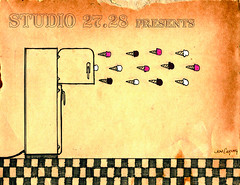
Mindy Kober and Kevin Margitich o2.o9
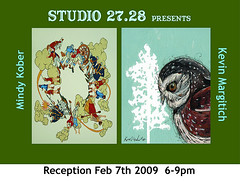
Allison Willse and Tamara Weiss o3.o9

Ed Trask o4.o9

Chase Lisbon o5.o9

Mike Torvato o6.o9
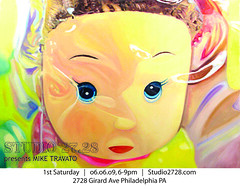
Joe Castro o6.o9

Bigfoot o7.o9
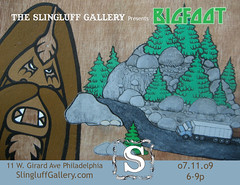
Peter Oravetz o8.o9
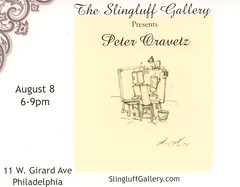
Jason Adams and Vanna Weaver o9.o9
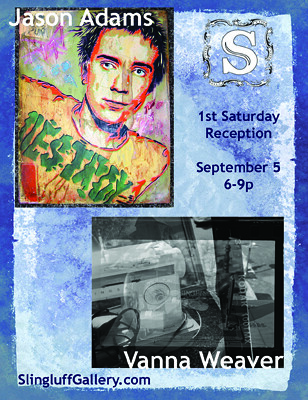
Good Wood 10.o9
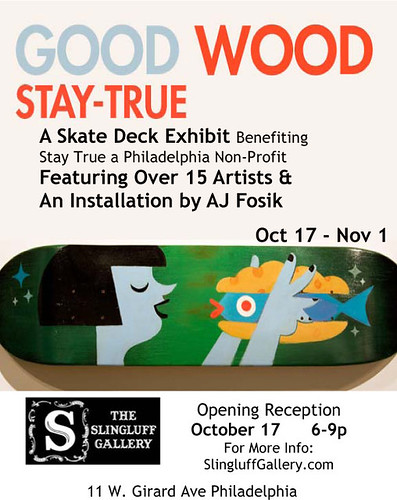
Nick Pedersen 11.o9
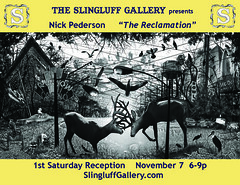
Karl P. Slingluff 12.o9

Mindy Kober o1.o10

The Slingluff Gallery
11 West Girard Ave.
Phila., Pa, 10123
215.307.1550
slingluffgallery.com

Mindy Kober and Kevin Margitich o2.o9

Allison Willse and Tamara Weiss o3.o9

Ed Trask o4.o9

Chase Lisbon o5.o9

Mike Torvato o6.o9

Joe Castro o6.o9

Bigfoot o7.o9

Peter Oravetz o8.o9

Jason Adams and Vanna Weaver o9.o9

Good Wood 10.o9

Nick Pedersen 11.o9

Karl P. Slingluff 12.o9

Mindy Kober o1.o10

The Slingluff Gallery
11 West Girard Ave.
Phila., Pa, 10123
215.307.1550
slingluffgallery.com
Subscribe to:
Posts (Atom)



